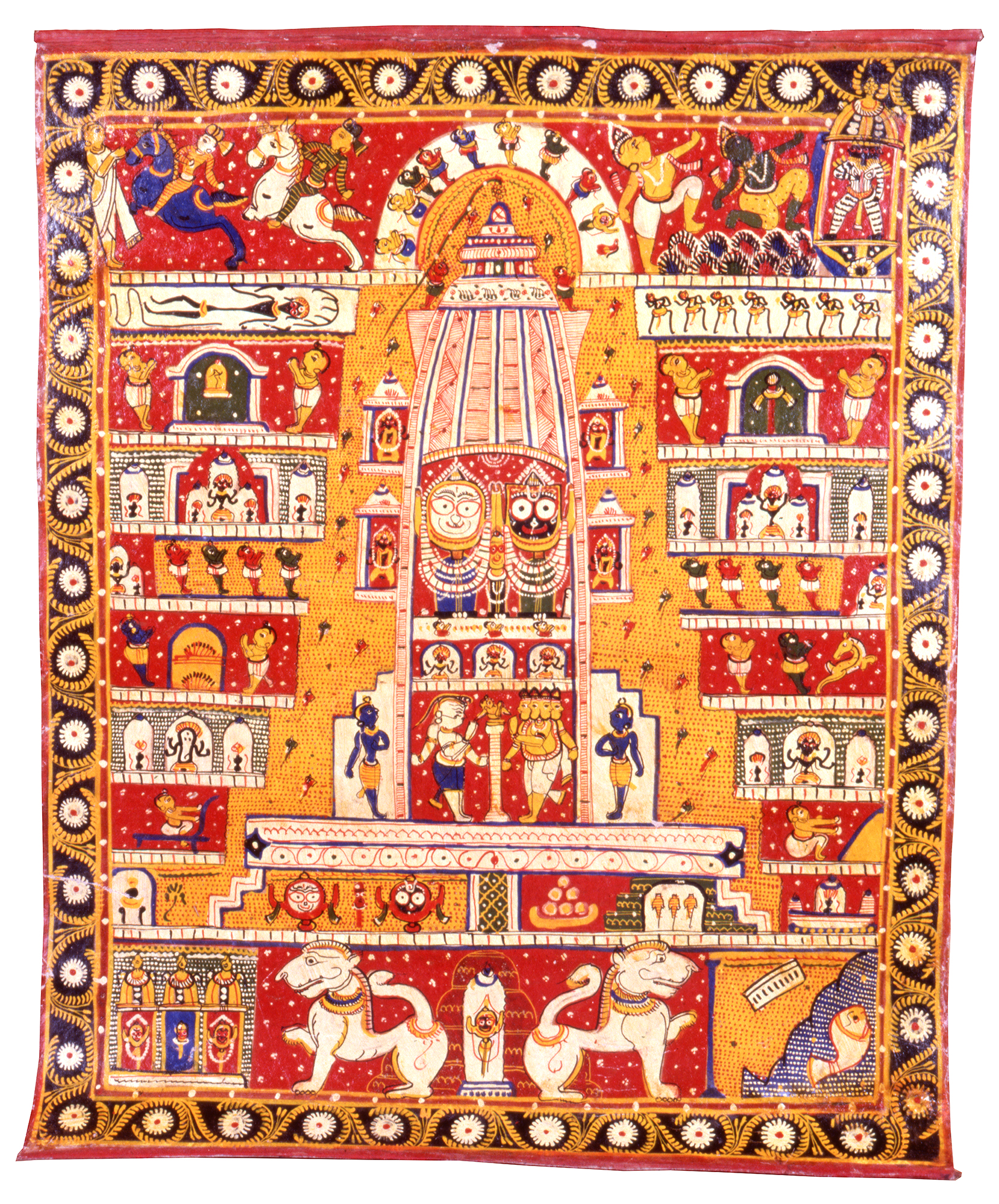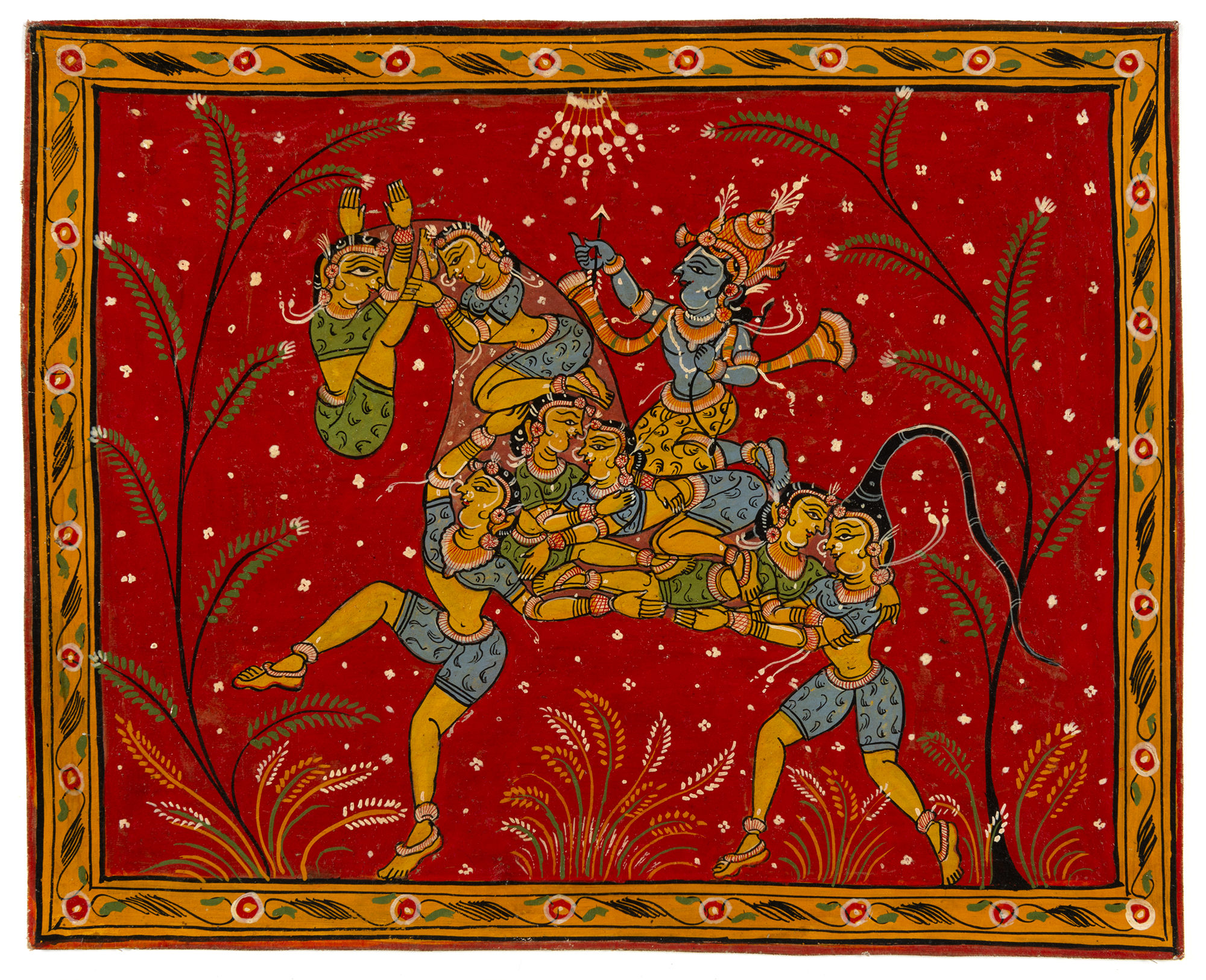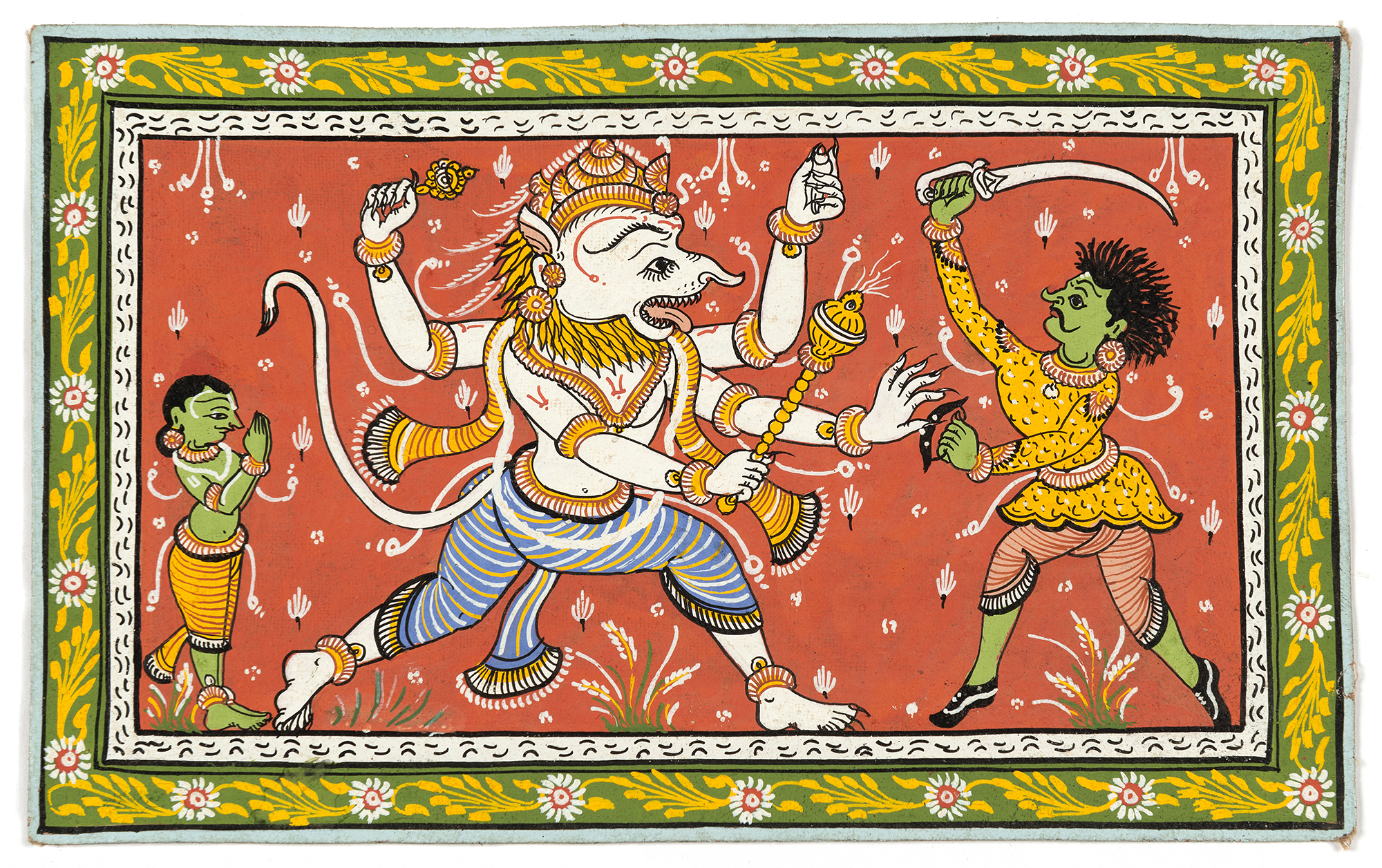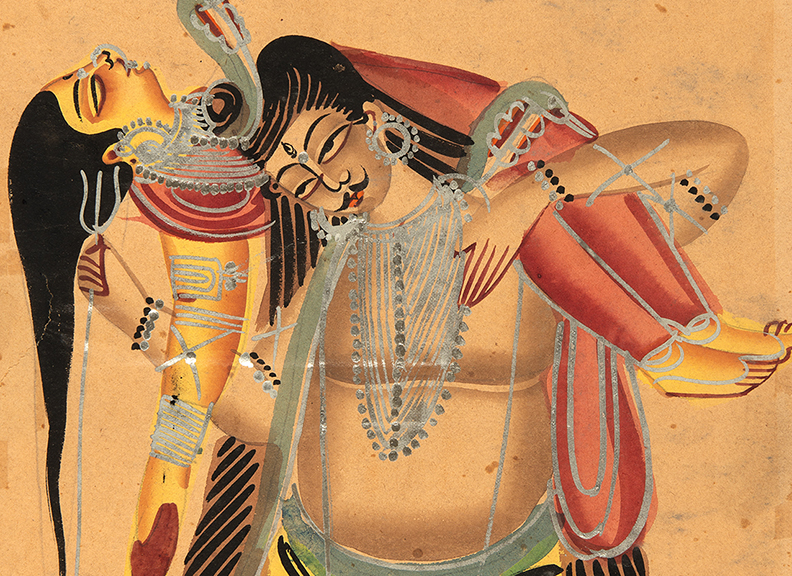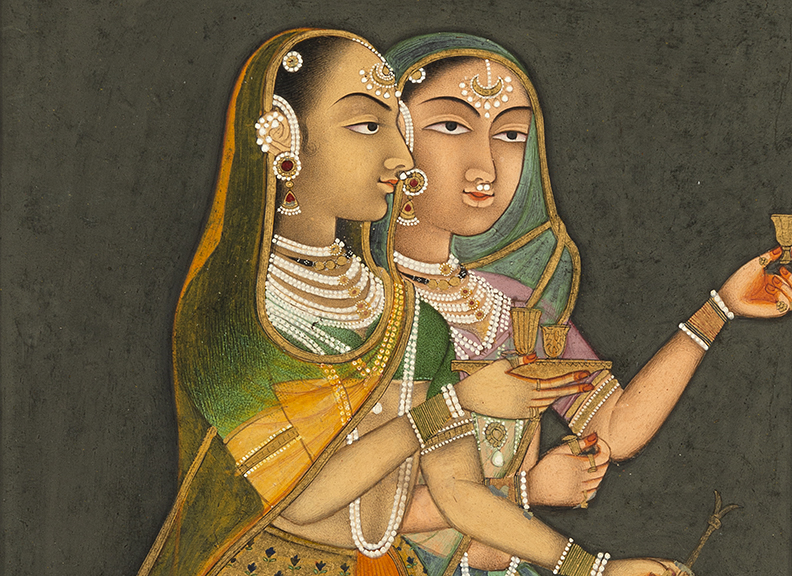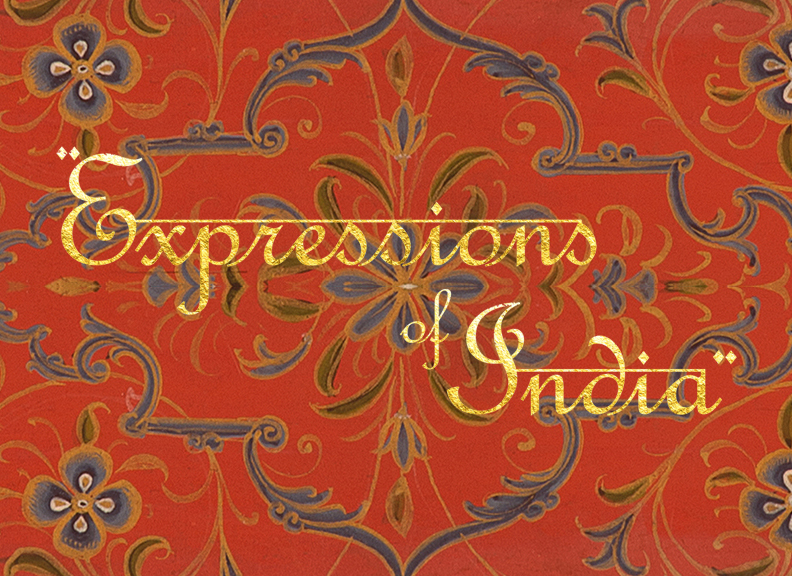Pattachitra, meaning ‘cloth-picture/painting’ in Sanskrit, is a generalised term used to describe a style and format of painting with origins in Odissa (now Odisha) and West Bengal. The centuries old tradition conducted by artisans, known as chitrakaras, has strong technical and stylistic similarities to the classical Indian wall murals and palm leaf manuscript illustrations. This style typically lacks perspectival recession and employs single tone backgrounds, a striking application of colour and predominantly profile portrayals. Furthermore, warm palettes dominate, making use of hand-mulled paints from readily available plant and mineral pigments, such as chalk or ground shell white, indigo, red lead, Indian yellow and charcoal-based black. The rise of the pattachitra practice is thought to centre on the city of Puri, within which is located one of the most significant sites of Hindu worship, Jagganath Temple. It is suggested that painted representations of the temple and its iconography on cloth were employed for worship at times when the temple was closed or inaccessible. This tradition quickly evolved into a demand for Jagganath pattachitra as pilgrim souvenirs, which served as a reminder and conduit for devotions. Pilgrims soon requested pattachitra portraying other deities and scenes from Hindu histories, scripture and narratives. The practice of painting this content in this manner likely grew outwards from Puri, encompassing much of Odissa and Bengal, providing to the masses not only a broadly attainable art form, but more importantly, readily accessible and transportable devotional iconography. The utility of these paintings in this manner is evident from the compositional device of the festooned fabric painted across the top of many of the works – suggestive of an enclosed shrine or stage, protective curtain drawn, deity poised within or narrative scene playing out.
The dissolution of the Mughal Empire’s dominance in the Odissa region by the Hindu-centric Maratha Confederacy, in the late eighteenth century, likely resulted in an influx in the availability and dissemination of pattachitra paintings. Governed by conventions, patterns emerged in the composition, portrayals and choice of scenes depicted by the chitrakaras. Eventually artisans inherited master-copies from which they based their trade. The growing presence of the British and other European nations in the region at the turn of the nineteenth century also impacted upon the pattachitra trade. Artisans began experimenting with secular content in an effort to appease the predominantly Christian foreigners. Furthermore, the readily available paintings, both religious and secular in nature, were acquired and sent back to Europe as tokens of the ‘exotic’.
This collection of paintings from the R.M and C.H bequest was likely acquired by Ronald and Catherine during their trip to India in 1965, during which time they visited Jagganath Temple and the surrounding district in Puri. One of the works included in this grouping is a prime example of a pilgrim souvenir pattachitra representing the temple and its devotional iconography.
Jagganath, Balabhadra and Subhadra at Puri Temple
Jagganath, Balabhadra and Subhadra at Puri Temple
Mid-20th century. Odisha, India. Opaque watercolour and unknown surface coating on cloth, 58.9 x 72.5 cm. Bequest of RM & CH Berndt, Berndt Museum of Anthropology Collection [1994/0806]
This painting is a definitive example of a Jagganath Temple pilgrimage souvenir pattachitra celebrating Jagganath along with his brother Balabhadra and sister Subhadra. The temple dedicated to Jagganath within Puri in the Odisha region of India has been one of the country’s most prominent Hindu pilgrimage sites for centuries.
Jagganath, lord of the universe, is a regionally worshipped deity and is considered an aspect or avatar of Vishnu. He is typically celebrated as part of a triumvirate with his brother and sister. The icons of this trinity are carved from sacred logs known as daru which are decorated with symmetrical faces, large eyes and an absence of appendages. They sit upon an ornately embellished dais or ratnabedi within the inner sanctum of the temple in Puri. Jagganath is distinguishable from his siblings with round eyes and face of black. In this pattachitra the three icons sit in the centre, against the towering sikhara structure of the temple, Balabhadra on the left and Subhadra characteristically between the brothers. Other aspects of significance at the temple site as well as scenes of Hindu narratives play out around them, including Dashavatara – the ten avatars of Vishnu – over the apex of the sikhara and a reference to the Ramayana in the top right corner.
Rama and Lakshmana Battle Ravana
Rama and Lakshmana Battle Ravana
Mid-20th century. Odisha, India. Opaque watercolour and unknown surface coating on cloth, 30.5 x 37.6 cm. Bequest of RM & CH Berndt, Berndt Museum of Anthropology Collection [1994/0827]
This pattachitra illustrates the iconic climactic final battle from the celebrated Hindu epic - the Ramayana. The unfairly exiled prince Rama with his brother Lakshmana and devoted monkey-general Hanuman lead an army of monkeys and bears against Ravana, the demon-king, who holds Rama’s beloved Sita prisoner. Rama, the seventh avatar of the deity Vishnu, depicted with green-skin, raises into the air the celestial golden bow named Sharanga, with which he will finally slay Ravana.
Krishna Riding a Composite Horse Made of Gopis (Milkmaids)
Krishna Riding a Composite Horse Made of Gopis (Milkmaids)
Mid-20th century. Odisha, India. Opaque watercolour and unknown surface coating on cloth, 24.7 x 37.5 cm. Bequest of RM & CH Berndt, Berndt Museum of Anthropology Collection [1994/0829]
This pattachitra depicts Krishna, eighth avatar of Vishnu, riding a composite horse made of gopis (milkmaids). Growing up amongst cowherds, Krishna was adored by the gopis during his adolescent period. He is often depicted surrounded by the beautiful maidens, incited and enchanted into revelry and dance by his roguish charms and charisma. In this painting the gopis composing the horse-form appear to prance, tumble and contort in a majestic acrobatic display of exuberance. Krishna is perched atop the formation cheerfully directing the spectacle with an arrow in one hand and Sharanga, celestial bow of Vishnu slung over his shoulder.
Narasimha Fighting Hiranyakashipu the Demon King
Narasimha Fighting Hiranyakashipu the Demon King
Mid-20th century. Odisha, India. Opaque watercolour on cloth, 12.8 x 20.4 cm. Bequest of RM & CH Berndt, Berndt Museum of Anthropology Collection [1994/0851]
This painting depicts the fourth avatar of Vishnu, Narasimha, battling the near-invincible demon Hiranyakashipu and protecting his devotee Prahlada. It is said that Hiranyakashipu obtained powers from the deity Brahma, with which he could not be slain during the day or night, with any weapon, inside or outside, by any man or animal. Corrupted by his power and arrogance the demon wrought havoc throughout the heavens and earth, persecuting those who would not bow to his will, including the followers of Vishnu. Hiranyakashipu’s own son Prahlada was one such devotee, refusing to renounce Vishnu when challenged by his father. Enraged by this perceived betrayal and defiance, Hiranyakashipu became hostile towards his son. In order to protect his faithful subject and defeat the demon, Vishnu emerged in the form of Narasimha, half lion, half man; neither fully man nor animal. With his mighty clawed hands he needed no traditional weapons. Narasimha fought with Hiranyakashipu and at the point of transition between night and day, in a location that could be perceived as either inside or outside, he plunged his hands into the demon’s chest, slaying him.
Krishna Steals the Garments of the Gopis (Milkmaids)
Krishna Steals the Garments of the Gopis (Milkmaids)
Mid-20th century. Odisha, India. Opaque watercolour on cloth, 30.6 x 22.7 cm. Bequest of RM & CH Berndt, Berndt Museum of Anthropology Collection [1994/0852]
This pattachitra derives from an iconic scene from the 22nd chapter, tenth canto of the Bhavagata Purana – one of the eighteen Hindu great histories. The chapter speaks of a group of unwed young gopis (milkmaids) who have taken vows of asceticism. Each wishing to marry the inimitable Krishna, eighth avatar of Vishnu, they beseeched the goddess Katyayani, through worship, for a betrothal. During the month of Margasirsa (November – December) these maidens would take each other’s hands, sing praise for Krishna and journey to the Yamuna River to bathe. Aware of the gopis’ activities, one day Krishna went down to the river where the maidens were bathing nude in the waters. Seeing that they had left their garments on the bank of the river, Krishna collected them all over his shoulder and climbed a nearby kadamba tree. Laughing and teasing the gopis, Krishna told them he understood how fatigued they must be by their vows of austerity and suggested they should each come out of the water and claim their clothes. Seeing the jest, the maidens countered that if he didn’t give back their garments they would tell the king, but if he did, they would see out his will as devoted servants. Not at all fearing the judgement of the king, Krishna informed the gopis that if they truly wished to become his maidservants, as he knew they did, they would heed his word, come out of the water and collect their clothes. Shivering from the cold water, the maidens acquiesced and coyly came out of the river covering their modesty with their hands. Not wanting ill to befall the gopis Krishna warned that by bathing naked in the midst of their vows, they risked the offense of the demigods, but if they joined palms in a sign of obeisance the offense would be forgiven. The young maidens did as Krishna said and in turn their clothes were returned.
Nataraja – Shiva as Lord of the Dance
Nataraja – Shiva as Lord of the Dance
Mid-20th century. Odisha, India. Opaque watercolour on cloth, 22.9 x 30.6 cm. Bequest of RM & CH Berndt, Berndt Museum of Anthropology Collection [1994/0853]
This pattachitra depicts Nataraja – the deity Shiva in the form of the divine dancer. The god is being fanned by the wizened devotee Bhringi to the right and the monkey Hanuman, sometimes thought to be an incarnation of Shiva, on the left. Nandi the bull, Shiva’s companion, mount and gate-guardian can be seen at his master’s feet.
The depiction of Nataraja in this painting is absent a number of the more classic iconographic elements. Representations of Shiva in this motion are typically associated with the playing out of the great cyclical drama of destruction and dissolution for the purpose of creation. In one hand he holds a small damaru (two-headed drum) and in another his iconic trishula (short-hafted trident). It is proposed the trishula is a symbolic reminder of the great trinities; past, present and future; creation, preservation and destruction; Brahma, Vishnu and Shiva. Cobras also feature throughout the painting, emblematic of Shiva’s assured dominance over all forms of evil.
The presence of Bhringi the emaciated, three-legged sage is representative of man’s devotion to Shiva and serves as a reminder within Shaivism. Parvati, Shiva’s goddess consort, rescinded the tantric feminine half of Bhringi’s body (flesh, muscle and blood), making him a sack of skin and bone. The sage had slighted the goddess through his zealous devotion to Shiva alone, failing to acknowledge Parvati as one half of the whole in Shaivism. Eventually taking pity on the remorseful sage, Shiva gave him a third leg so that he could again stand.
Narasimha – Fourth Avatar of Vishnu
Narasimha – Fourth Avatar of Vishnu
Mid-20th century. Odisha, India. Opaque watercolour on cloth, 30.6 x 22.7 cm. Bequest of RM & CH Berndt, Berndt Museum of Anthropology Collection [1994/0854]
This pattachitra depicts the mighty fourth avatar of Vishnu, Narasimha, the half-lion, half man. He sits cross-legged upon a dais, his two upper arms hold two of the four emblems of Vishnu, the chakra (discus) and shankha (conch shell). His upper hands also form the Karana Mudra, a gesture used to expel evil, while his lower hands are extended downwards with palm out in the Varada Mudra, a gesture of giving. Prahlada the devotee, the protection of whom is often said to be the catalyst for Vishnu’s incarnation in this form, sits over the avatar’s heart. This is perhaps symbolic of the rightful place of those with unwavering faith in the deity.
Anantashayana Vishnu
Anantashayana Vishnu
Mid-20th century. Odisha, India. Opaque watercolour on cloth, 19.9 x 26.9 cm. Bequest of RM & CH Berndt, Berndt Museum of Anthropology Collection [1994/0857]
This pattachitra depicts Anantashayana Vishnu – Vishnu sleeping on Ananta Shesha, the endless serpent – and explores the story of the creation or re-creation of the universe. The universe is formed by Brahma the creator, sustained by Vishnu the preserver and eventually unmade by Shiva the destroyer in a constant cycle. It is said that the universe shares the lifespan of Brahma, who upon reaching the end of one lifespan is reborn from a lotus blossom that grows from Vishnu’s navel.
Vishnu is portrayed in the painting resting from the arduous feat of sustaining the prior universe. In the midst of the Ocean of Being, he reclines upon Ananta Shesha, the multi-headed serpent, who is typically associated with the passage of time. From his navel sprouts the lotus blossom, upon which Brahma has been reborn. Vishnu’s goddess consort Lakshmi tends to her beloved’s weary feet and seated behind her, awaits the goddess of wisdom, arts and knowledge, Saraswati, the feminine counterpart to Brahma.
Krishna Defeating Kaliya the Naga Serpent
Krishna Defeating Kaliya the Naga Serpent
Mid-20th century. Odisha, India. Opaque watercolour on cloth, 20.4 x 17.6 cm. Bequest of RM & CH Berndt, Berndt Museum of Anthropology Collection [1994/0858]
This pattachitra illustrates a scene from the sixteenth chapter, tenth canto of the Bhavagata Purana – one of the eighteen Hindu great histories. This chapter speaks of a great multi-headed serpent named Kaliya, who resides in the depths of the Yamuna River. Kaliya pollutes the river with his poison and terrorizes the nearby Gokul people if they stray too close to his domain, including, most significantly, Krishna’s beloved Radha. Angered by the great serpent’s actions, Krishna confronts Kaliya, who with his tail ensnares the eighth avatar of Visnhu and drags him into the river’s depths. Kaliya begins to constrict Krishna with his body, but the mighty deity incarnate expands himself until the great serpent is forced to release him. Krishna then jumps onto Kaliya and begins to dance on his many heads, causing the serpent to expel all his poison so that he can no longer pollute the Yamuna River. Assuming the weight of the universe Krishna continues to beat Kaliya to near death with his feet. Seeing that their husband was about to die, the naga (half-woman, half-snake) wives of Kaliya beseech Krishna with palms joined for mercy. Acknowledging the might of Krishna, Kaliya surrenders, promising not to terrorize anyone again and agreeing to leave for Ramanaka Island.
In the painting Krishna appears to be portrayed in his expanded form, grasping Kaliya’s tail whilst dancing on the serpents many heads. He holds in his other hand his magical bamboo flute, eliciting the rhythm of the dance. The naga wives of Kaliya are represented on either side of the scene, palms joined in prayer and reverence to Krishna.
Krishna with his Consort Radha
Krishna with his Consort Radha
Mid-20th century. Odisha, India. Opaque watercolour on cloth, 27.6 x 26 cm. Bequest of RM & CH Berndt, Berndt Museum of Anthropology Collection [1994/0860]
In this pattachitra Krishna, eighth avatar of Vishnu and his beloved Radha are depicted in an iconic embrace. Their bodies are entwined in a near symmetrical union of form as they gaze adoringly into each other’s eyes. The lovers both appear to hold Krishna’s bamboo flute, with which he enthrals and incites passion. He lovingly cups the back of her head as if in the process of stealing a kiss. The branches of a tree symbolically in full blossom waver behind the pair as petals shower across the scene. Gopi (milkmaid) handmaidens stand to either side, all the while devotedly fanning the couple.
Many Armed, Dancing Ganesha
Many Armed, Dancing Ganesha
Mid-20th century. Odisha, India. Opaque watercolour on cloth, 26.3 x 27.6 cm. Bequest of RM & CH Berndt, Berndt Museum of Anthropology Collection [1994/0861]
This pattachitra depicts the widely celebrated and worshiped deity Ganesha in a dancing pose. The deity with distinctive elephant head and rotund belly is typically known as the remover of obstacles, bringer of good fortune, god of learning and patron of the arts and sciences. Prayer and offering is usually made to Ganesha before the commencement of any venture or undertaking, strengthening its chance of success or completion.
A man and woman are depicted in poses of obeisance to either side of Ganesha and could be representations of his deity parent-figures Shiva and Parvati. He holds aloft a sacred thread in the form of a serpent and he dances upon an open padma (lotus flower), which in Hinduism is typically emblematic of purity, divinity and spiritual enlightenment. Ganesha’s mouse mount Dinka attends to the god at his feet. Some sources suggest that the tiny creature, often seen carrying the hefty deity, symbolises the denial of selfish or greedy urges as well as the overcoming of adversity with the blessing of Ganesha. The god holds in his lower right hand the broken half of one of his tusks. There are a few differing narratives as to how the tusk was broken, but one tells of how the sage Vyasa, composer of the epic poem The Mahabharata, asked that Ganesha transcribe the poem as he dictated. Ganesha agrees to undertake the task, with the stipulation that Vyasa recite the epic from start to finish without pause. The dictation begins, but midway through Ganesha’s feather pen breaks. To ensure that the transcription remained uninterrupted Ganesha broke off the end of his tusk, which he then used as a pen to complete the project.
Matsya Slaying the Demon Shankhasura
Matsya Slaying the Demon Shankhasura
Mid-20th century. Odisha, India. Opaque watercolour on cloth, 30.5 x 40.6 cm. Bequest of RM & CH Berndt, Berndt Museum of Anthropology Collection [1994/0862]
This pattachitra depicts Matsya, first avatar of Vishnu battling the demon Shankhasura in the depths of the ocean. It is said that during the cosmic age when the earth was predominantly submerged by water, the demon Shankhasura stole the Vedas (scriptures) from the god Brahma. He entrenched himself in the depths of the vast ocean, thinking himself unreachable. The deity Vishnu, sustainer of the universe, took the form of the half-fish, half-man avatar Matsya, to delve beneath the waves, slay Shankhasura and retrieve the sacred Vedas.
Shankhasura can be seen emerging from his refuge within a large conch shell, confronted by Matsya, who postures formidably, holding in each hand one of the four emblems of Vishnu – chakra (discus), padma (lotus), shankha (conch shell) and gada (mace).

